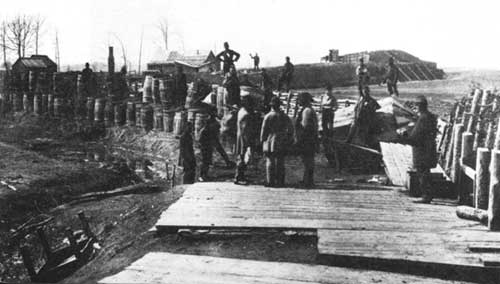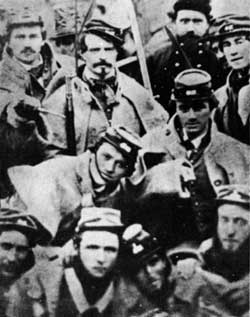|
MANASSAS National Battlefield Park |
 |

Confederate fortifications at Manassas, Va.
Waritime photograph. Courtesy National Archives.
McDowell Tests the Confederate Right
 Young Confederates in Richmond who were soon to receive their baptism of fire at the First Battle of Manassas. From "Photographic History of the Civil War." |
On July 18, in a feeling movement on the Confederate right, Tyler made a thrust against Beauregard's troops stationed in the vicinity of Blackburn's Ford. The affair got somewhat out of hand with the result that the Federal force was smartly repulsed. The action had a depressing effect on Union morale but greatly boosted that of the Confederates. There then followed 2 days of costly delay for McDowell during which time he brought forward his supplies—a delay the Confederates were quick to capitalize upon. To the sound of the axe and the crash of falling trees, they built roadblocks along the Warrenton Pike in the vicinity of the Stone Bridge and in general strengthened their defenses. More important, the delay gave Johnston much needed time in which to reach Manassas.
Confederate reinforcements were now steadily moving in. On the 19th, Jackson arrived 2,500 strong, having covered approximately 55 miles in 25 hours. At sunrise of the 20th, more of Johnston's reinforcements had come in—the 7th and 8th Georgia regiments of Barrow's brigade numbering 1,400 men. About noon, Johnston himself arrived accompanied by Bee, the 4th Alabama, the 2d Mississippi, and two companies of the 11th Mississippi. The Confederate camp now became a scene of busy activity. While the reinforcements moved up to position in the line, Beauregard and Johnston conferred on plans for an offensive. Candles burned low in headquarters that night as Beauregard and his staff put the finishing touches to the Confederate plan of attack: At 4:30 a . in., he submitted it to Johnston, his superior, for the approval that was quickly granted. The plan involved the flanking of the Federal left, but the early movement of McDowell, the delayed arrival of expected reinforcements and the miscarriage of orders combined to prevent its execution.

|

|
|
Last Modified: Sat, Apr 7 2001 10:00:00 am PDT |


